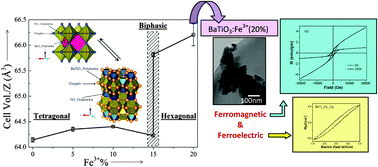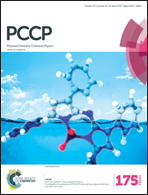Phase evolution in sonochemically synthesized Fe3+ doped BaTiO3 nanocrystallites: structural, magnetic and ferroelectric characterisation†
Abstract
The properties of nanomaterials are highly dependent on their size, morphology, crystal phase, etc., which in turn depend on the method of synthesis. We report here the electrical and magnetic characterisation of sonochemically synthesized Fe3+ doped nano BaTiO3 samples. The dopant ion concentration has been optimized and the coexistence of ferromagnetism and ferroelectricity has been observed in the sample. With increase in Fe3+ doping from 0 to 20 mol%, a gradual phase change from tetragonal to hexagonal occurred in these sonochemically synthesized BaTiO3 nanomaterials. Below 15 mol% Fe concentration the material displays ferroelectric behaviour with the absence of any magnetic ordering, while at an Fe concentration of ∼15 mol% the material exhibits both room temperature ferromagnetism and ferroelectricity. Ferromagnetism as well as relaxor type behaviour has been observed in the BaTiO3:Fe3+(20%) sample. We have studied the ferromagnetic and ferroelectric ordering in these sonochemically synthesized Fe3+ doped BaTiO3 nanomaterials and have tried to correlate the results with their crystal structure and morphology. The origin of ferromagnetism in these materials has been attributed to both intrinsic as well as extrinsic factors.


 Please wait while we load your content...
Please wait while we load your content...